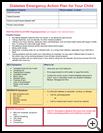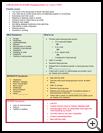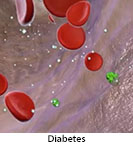
Glucose Tolerance Test
________________________________________________________________________
KEY POINTS
- The glucose tolerance test measures your child’s body’s response to glucose (sugar). The most common use of this test is to check for diabetes.
- Your child’s healthcare provider will take a small amount of blood from your child’s arm with a needle. Your child will then be asked to drink a liquid containing a certain amount of glucose. Your child will have repeat blood tests in 1, 2, or 3 hours after having this drink. The blood is collected in tubes and sent to a lab.
- Talk to your child’s healthcare provider about what the test results mean and ask any questions you have.
________________________________________________________________________
What is the glucose tolerance test?
The glucose tolerance test (GTT) measures the body’s response to glucose (sugar). The body breaks down some of the foods your child eats into glucose. The blood carries the glucose to the cells of your child’s body. Your child needs some glucose in the cells for energy, but too much glucose in the blood is not good for your child’s health. This test will be done after your child has fasted, and again a few hours after your child drinks a special glucose drink.
This test is also called an oral glucose tolerance test (OGTT).
Why is this test done?
The most common use of this test is to check for diabetes. Diabetes is a problem with the way the body makes or uses insulin. Insulin is made by the pancreas, which is an organ in the upper belly. The body uses insulin to help move glucose from the blood into the cells. When the body does not have enough insulin or has trouble using the insulin the body makes, glucose cannot get into the cells and builds up in the blood.
How do I prepare my child for this test?
If your child is having a fasting glucose test, your healthcare provider will tell you when your child should stop eating and drinking before the test. In most cases, your child should eat nothing and drink nothing but water for at least 8 hours before the test.
If your child is having a random or timed test, follow the instructions from your healthcare provider.
Your child may need to avoid taking certain medicines before the test because they might affect the test result. Make sure your healthcare provider knows about any medicines, herbs, or supplements that your child is taking. Ask your provider before stopping any of your child’s regular medicines.
Talk to your child's healthcare provider if you have any questions about the test.
How is the test done?
Your healthcare provider will take a small amount of blood from your child’s arm with a needle.
Your child will then drink a liquid containing a certain amount of glucose. It tastes very sweet. Your child will have repeat blood tests every 1, 2, or 3 hours after your child has the glucose drink.
Ask your healthcare provider when and how you will get the result of the test.
What does the test result mean?
Your child’s blood glucose level may be higher than normal (hyperglycemia) if:
- Your child has prediabetes (his blood glucose is higher than normal, but not quite high enough to be called diabetes).
- Your child has diabetes.
- Your child has kidney or liver disease.
- Your child's pancreas is inflamed. The pancreas is an organ in your upper belly that makes insulin.
- Your child's body is severely stressed from a bad infection or injury.
- Your child is taking medicine such as steroids, which can raise blood glucose level.
Your child's blood glucose level may be lower than normal (hypoglycemia) if:
- Your child's thyroid, pituitary, or adrenal glands are not working normally. These glands make hormones, which are chemicals that help with things such as growth, development, and control of blood pressure and blood glucose.
- Your child has liver disease.
- Your child has problems absorbing food.
- Your child is not getting the nutrients needed from food.
What if my child's test result is not normal?
Test results are only one part of a larger picture that takes into account your child's medical history and current health. Sometimes a test needs to be repeated to check the first result. Talk to your child’s healthcare provider about the result and ask questions, such as:
- If your child needs more tests
- What kind of treatment your child might need
- What lifestyle, diet, or other changes your child might need to make
Last modified: 2017-01-09
Last reviewed: 2017-01-05



